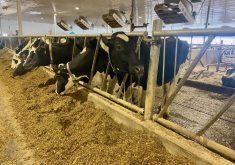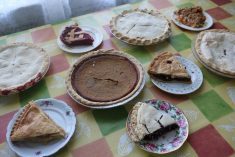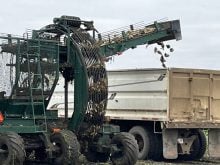Harvest was completed early in west-central Saskatchewan this year. There will be a longer-than-normal fall to do fall jobs. Maybe even a few extras will get taken off the “to do” list. With harvest over, taking a drive to visit friends or a trip somewhere before winter comes are options. Here’s hoping.
New product
Canadian shoppers can now buy a creamy vegetable oil made with canola. This Unilever product was recently introduced as Imperial Culinesse.
Imperial Culinesse can burn at higher temperatures without browning. It starts to get brown at temperatures over 200 C. The ideal temperature for frying is 180Ð190 C.
Read Also

Accurate accounting, inventory records are important
Maintaining detailed accounting and inventory records is not just a best practice; it’s a critical component of financial health, operational efficiency and compliance with programs like AgriStability.
It doesn’t burn like butter. Milk proteins burn and turn brown soon after the temperature in the pan rises. Unlike butter and most margarines, Imperial Culinesse does not contain milk proteins.
It doesn’t spatter like oil. The addition of a natural extract from soybeans helps reduce spattering when cooking at high temperatures.
The ingredients in Imperial Culinesse, in order of quantity from largest to smallest, are: canola oil, water, hydrogenated vegetable oil, salt, soy lecithin, artificial flavour, citric acid and beta-carotene.
Making sauerkraut
Dear TEAM: I would like to make sauerkraut, the kind you buy in the stores. – N.M., Sangudo, Alta.
Dear N.M.: Freshly picked cabbage – no more than two days old – is important for the best sauerkraut. For best flavour, use homemade sauerkraut within six months. Sauerkraut is fermented cabbage that requires consistent monitoring and attention for a three- to six-week fermentation period. If you are up to that, here is the recipe:
25 pounds white 11.3 kg
cabbage, about five
large heads
3/4 cup pickling salt 175 mL
Working with five pounds (two kg) cabbage at a time, discard outer leaves. Rinse heads under cold running water and drain. Quarter cabbage and remove cores. Shred or slice 1/16 inch (two mm) thick. Remove large pieces. Add three tablespoons (45 mL) pickling salt to shredded cabbage; mix thoroughly and let stand a few minutes until cabbage begins to wilt and juices begin to flow. This allows packing with minimal breaking or bruising of shreds. Pack salted cabbage firmly and evenly into a clean, five gallon (20 L) crock, glass or stainless steel container.
Repeat shredding, salting and packing five lb. batches until all cabbage is in the container. Be sure cabbage is at least four inches (10 cm) below rim of container. If liquid does not cover cabbage, add boiled, cooled brine (11/2 tablespoons/20 mL) pickling salt to four cups/one L water.
Weight cabbage to keep it one to two inches (2.5 to five cm) under the brine throughout fermentation. Place a clean dinner or glass pie plate on top of the cabbage inside the fermentation container. The plate must be slightly smaller than the container opening, yet large enough to cover most of the shredded cabbage. Fill two or three clean one L mason jars with water and close lids tightly. Place jars on plate to weight cabbage. Cover the container with a clean, heavy bath towel to keep out airborne contaminants.
Store at 70 to 75 F (21 to 24 C) for three to four weeks. At temperatures between 60 to 65 F (16 to 18 C), fermentation may take five to six weeks. At lower temperature, sauerkraut may not ferment; at higher temperature, it may become soft.
Check the sauerkraut daily and skim off scum. Fermentation is complete when bubbling ceases.
When sauerkraut has fully fermented, store tightly covered in the refrigerator for several months or use the heat process as follows in mason jars.
Place desired number of clean 500 mL or one L mason jars on a rack in a boiling water canner; cover jars with water and heat to a simmer (180 F/82 C). Set screw bands aside; heat snap lids in hot water, not boiling. Keep jars and snap lids hot until ready to use.
Hot pack: Place sauerkraut in a large stainless steel saucepan; slowly bring to a boil, stirring frequently.
Cold pack: Do not heat sauerkraut before filling jars.
Pack sauerkraut into hot jars to within 1/2 inch (one cm) of top rim (headspace).
Using a non-metallic utensil, remove air bubbles. Wipe jar rim, removing any stickiness. Centre snap lid on jar; apply screw band firmly until resistance is met – fingertip tight. Do not overtighten. Place jars in canner.
Cover canner; bring water to a boil. For altitudes up to 1,000 feet (305 metres), process 500 mL jars for 10 minutes (hot pack) or 20 minutes (cold pack); one L jars for 15 minutes (hot pack) or 25 minutes (cold pack). Increase processing time by five minutes for altitudes 1,001-3,000 feet (306-915 m) or 10 minutes for altitudes 3,001-6,000 feet (916-1,830 m).
Cool upright, undisturbed 24 hours. Store in a cool, dark place.
Source: Bernardin Guide to Home Preserving, 3rd edition August 2003, $8 (an excellent new resource.)
Sewing machine manual
Dear TEAM: Does anyone have a manual for a Brother Festival 461 sewing machine or know where I can order one? – Hodgeville, Sask.
On the internet I found you can order this manual from www.sew4less.com or Discount Sewing Machine Parts & Manuals, 332 White Road, Oakdale, Louisiana 71463, 318-335-0963. The U.S. price listed was $15.95.
Breadmaker repair
Dear TEAM: We have an American Harvest Dual Chamber Breadmaker Model BC2000 that needs repair. We were using this machine in our long-term care facility for our residents. Do you know of any place that fixes these or that we can contact to get a part? – K.D., East Central Health.
Dear K.D.: Appliance repair depots told me the American Harvest Company is no longer in Canada and they did not think it would be possible to get parts. You could try contacting the U.S. company at Nesco/American Harvest, Box 237, 1700 Monroe St., Two Rivers, Wisconsin, 54241, www.nesco.com/support/service/.
They list a service depot at Morrells Vacuum and Appliances, 207 Fort St., Winnipeg, Man., R3C 1E2.
Tap water scalds
Hot water burns like fire. Unfortunately, many families are not aware of the dangers of hot water in their households until it is too late.
Each year, more than 500 children in Canada are hospitalized because they were burned by hot tap water. The statistic has not changed in more than 20 years.
Fortunately, there are few deaths associated with scalds, but they can result in permanent scarring, physical and emotional disability and years of skin grafting operations.
The body surface area of full-thickness burns caused by tap water scalds is almost twice that of other scalds. At the Hospital for Sick Children, children scalded by hot tap water are hospitalized for approximately 23 days.
In Canada, most home hot water heaters are set at 60 C. At this temperature, water burns human skin in one to five seconds. The young and the elderly are most at risk because they tend to have a slower reaction time and thinner skin.
A slight reduction in hot water heater temperatures would significantly reduce the number and severity of injuries. For example, it would take 10 minutes for a child to suffer a third degree burn in 49 C water, but a second or less at 60 C.
Safe Kids Canada, is a non-profit national injury prevention program of the Hospital for Sick Children
It has worked with the Canadian Advisory Committee on Plumbing, proposing a change to the code limiting the temperature of hot water at plumbing fixtures to 49 C.
The National Building Code now allows a maximum tank temperature of 60 C. The Canadian Commission on Building and Fire Codes will meet this month to decide. If adopted, it will become part of the code by 2005.
More than 20 years ago, several American states mandated that hot water tanks be installed and pre-set at 49 C. In the state of Washington, hospital admissions for tap water injuries were reduced by half within the first five years.
In 1988, the industry voluntarily agreed to pre-set hot water tanks across the U.S. to 49 C. However, American products shipped into Canada are still set at 60 C.
For more information or tips on safety measures in this or other areas, contact: Safe Kids Canada, 888-SAFE-TIPS (723-3847) or at www.safekidscanada.ca. As well, contact Rita Mezei, public policy and advocacy specialists at Safe Kids Canada, 416-813-6144 or e-mail rita.mezei@sickkids.ca.
Source: Safe Kids Canada & Canada Safety Council.
Alma Copeland is a home economist from Rosetown, Sask., and one of four columnists comprising Team Resources. Send correspondence in care of this newspaper, Box 2500, Saskatoon, Sask., S7K 2C4 or contact them at team@producer.com.














